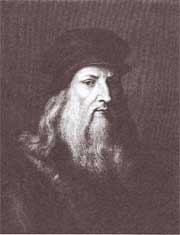Leonardo da Vinci - Biography
Leonardo da Vinci's biography is that of a true Renaissance man, going seamlessly from art to science, in a succession of so many accomplishments that it is really hard to believe they could belong to a single human life.

Leonardo da Vinci
Leonardo da Vinci Biography - Early years and youth
Leonardo da Vinci was born in 1452, at Vinci, in the Val d'Arno, as the illegitimate son of a notary, Ser Piero, and a peasant girl named Catherina. His early years already began to uncover the inquiring mind which stamps the future man of science. Vasari says that, "In arithmetic, he often confounded the master who taught him, by his reasonings and the difficulty of the problems he proposed." But the world was in the infancy of science, while art attained maturity, covering a far greater area of intellectual ground than it does now. Science was then a suspicious occupation, while art was a profitable one, and a parent had to take this into account when deciding which way his son should go.
In 1469, his father decided to apprentice his son to the distinguished Florentine artist, Andrea di Cione, called Verrocchio. It has been usual to depreciate the merit of this master in order, unnecessarily, to exalt that of his scholar. But the familiar appellation of "Verrocchio", or the "True Eye", implies that quality for which Leonardo became most famed, and which it is fair to believe the teacher contributed to form.
In other respects, too, Verrocchio occupies that stage which led upwards to Leonardo. He was not only sculptor, goldsmith, carver, and painter, but also a student of perspective and a musician. One of Verrocchio's creations related to Leonardo is the bronze statue of David. It is believed that the well built youth actually represents the apprentice, Leonardo. And this is quite possible, as the tradition and Vasari himself are asserting Leonardo's beauty.
Beside his physical beauty, the young Leonardo was an accomplished dancer, a musician, an "improvisatore", and a poet, but also a sportsman, delighting himself in mastering the wildest horse, and boasting a strength that could bend the horse shoe. Leonardo da Vinci did not quit Verrocchio until 1477 when he set up a bottega (workshop) for himself.
A pen drawing showing a valley between two ranges of hills, with the view of a fortified town on the left, is inscribed " the day of S. Mary of the Snow, the 5th day of August, 1473." It is the earliest of Leonardo's dated work.
In January 1478 he received an important order from the State, an altarpiece for the chapel in the Signorial Palace, dedicated to St. Bernard, after the contract made with Pietro Pollaiuolo was cancelled. It is not known if Leonardo ever touched this picture. After he left Florence, the work was passed to Ghirlandaio, who also did little to it. The canvas was finally carried out by Filippino.
His first great composition, Adoration of the Magi (1481), was a commission from the Monks of St. Donato a Scopeto. It is a very complex composition, for which Leonardo did numerous drawings and preparatory studies, including a study in the perspective of the ruined staircase in the background. But in 1482 Leonardo went to Milan, and the painting was abandoned.
There are many speculations regarding the possible reasons Leonardo had to leave Florence. Leonardo da Vinci biography is marked by the strange neglect of the Medici (he does not seem to have had a single commission from any one of them). That would tend to show that Leonardo was not properly appreciated in his native city. Added to this, there may have been family difficulties, money matters, and maybe, a desire for change. Another possible reason would be simply the lack of sympathy between Leonardo and the Medici.
Leonardo was first a scientist, while the Medici were ardent Platonists. That he rested his claim and patronage far less on his art than on his mechanical inventions, is obvious from the letter—supposed to have been written about 1481—addressed by him to Lodovico Sforza, called Il Moro, third son of the condottiere Francesco Sforza—the regent, and ultimately the usurper, of the Milanese Duchy.
This letter is remarkable in every way, as a marvelous prospectus of his own powers, a characteristic page in the Italian history of the 15th Century, where the demands of war and of peace stand in curious disproportion, and where his art of painting comes in apparently as an afterthought. This letter seems to have obtained for Leonardo the desired invitation to the court of Milan, accompanied with a salary.
In his pages dedicated to Leonardo da Vinci biography, Vasari says that this happened chiefly because the Duke wished to hear him singing, an accomplishment of which the letter makes no profession. There can be no doubt that music was one of Leonardo's acquirements, and musical instruments among his inventions; new forms of the lyre, and improvements of sounding-board are sketched and described in his manuscripts. Arnoretti also speaks of the frontispiece to a treatise on music, dedicated by a Florentine priest to Ascanio Sforza, brother to Lodovico, in which Leonardo is represented with a guitar in his hand.
Leonardo da Vinci Biography Continued:
Leonardo da Vinci in Milan
Leonardo da Vinci in Florence and Urbino
Leonardo da Vinci - Last years in France